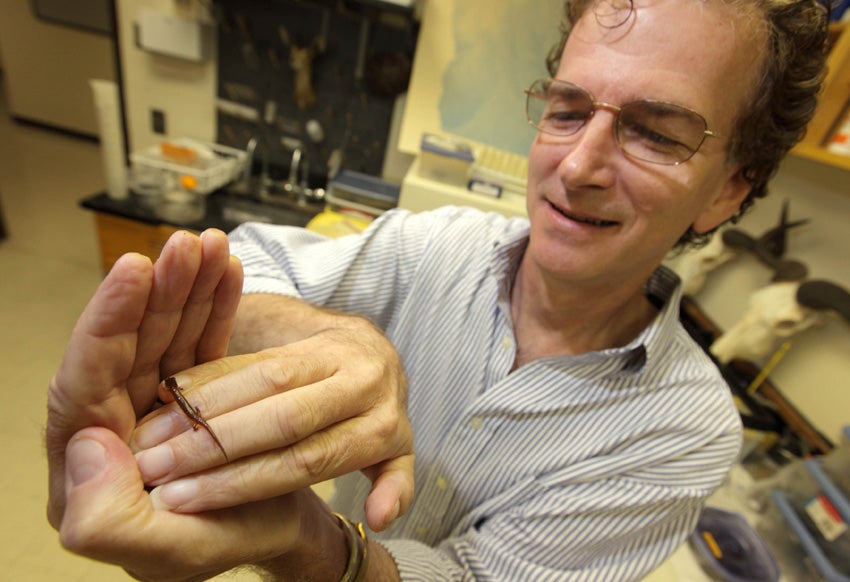ECU professor plays role in identifying new salamander

Dr. Trip Lamb of East Carolina University holds the “patch nosed salamander,” a new genus and species of lungless salamander that he helped identify. ECU News Services photo by Cliff Hollis.
GREENVILLE, N.C. — An East Carolina University faculty member shares credit for discovering a new genus of salamander from the southern Appalachians.
Dr. Trip Lamb, professor in the Department of Biology in the Thomas Harriot College of Arts and Sciences, co-authored the article in the Journal of Zoology’s September issue that details the finding and classification of the new genus and species of lungless salamander.
It’s the first new genus of amphibian to be described from North America in 50 years. The researchers call it the “patch nosed salamander” for the yellow patch on its snout.
Around the world there are approximately 500 species of salamander. North Carolina boasts a high species count for salamanders with nearly 60, said Lamb.
Lamb’s co-authors are graduate students Bill Peterman of the University of Missouri and Joe Milanovich of the University of Georgia, who found the tiny salamander; ecologist J.C. Maerz, Milanovich’s major professor at UGA; herpetologist Carlos Camp at Piedmont College, who performed the initial identification; and David Wake at the University of California-Berkley, a comparative anatomist and an expert on lungless salamanders.
Lamb had been contacted by Camp at Piedmont College to help with the initial identification as more and more facts pointed to a new species. “I first compared DNA sequences from the new salamander with those of several brook salamanders and related genera,” said Lamb, an evolutionary biologist.
As he began the analysis, Lamb said that he joked with his graduate student, David Beamer, “Wouldn’t it be wild if this fell outside of the brook salamanders? And it did. We were stunned.”
Lamb’s sequencing showed high levels of genetic divergence relative to the brook salamanders, so Camp toyed with the idea of describing it as a new genus, he said. That’s when Wake, the world’s expert on lungless salamanders, was called in.
The new species is Urspelerpes brucei; the specific epithet commemorates Dick Bruce, a well-known salamander ecologist who was director of the Highlands Biological Station in western North Carolina, Lamb said.
The lungless salamanders belong to the family Plethodontidae, the largest and most geographically widespread family of salamanders. Of the 580 species of salamander, nearly 400 are plethodontids, he said. They exchange respiratory gases (oxygen, carbon dioxide) through their thin moist skin and the lining of the mouth, as all amphibians do, but for lungless salamanders, skin is their only avenue for gas transfer.
“One of the more remarkable things about this new salamander is that it occurs right here in the United States, opposed to some remote tropical locale, and in the Appalachian Mountains, a region well known for its salamander diversity and one well studied by biologists,” Lamb said. “Yet this species eluded discovery until 2007.”
The new species, at 25 to 26 mm, vies with the pigmy salamander for the tiniest species of salamander in the United States.
“Discovering something like this is luck of the draw,” Lamb said. “It’s a matter of serendipity that these guys found this salamander. And describing a species new to science is pretty exciting.”